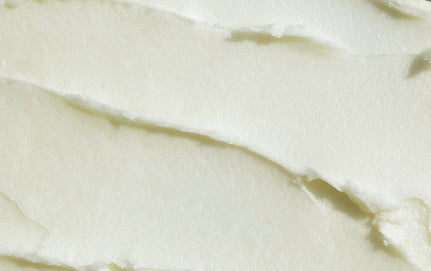The shea seed contains a rich butter full of beneficial nutrients, even though it’s a hard nut to crack.
Plant name (Latin): Butyrospermum parkii
Plant family: Sapotaceae
Native region: The dry, arid savanna belt of West Africa
Growing habit: A densely-branched tree with regular, shiny green leaves and fruits that resemble large plums, with the shea nut at the centre
Parts used: Fruit and nut
Essential oil extraction method: Ground shea nut is simmered in water
About Shea Butter
Rich, moisturizing shea butter—valued for centuries in Africa as a food, traditional remedy and cosmetic—is processed from shea nuts, which grow on trees found only Africa’s dry savanna belt. Soothing shea butter is all-natural source of moisture and protection for dry and chapped skin.

Why Use Shea Butter
Richly soothing and hydrating, shea is used as a balancing moisturizer for dry skin, as a dry scalp treatment, for chapped lips and to help soften cracked, dry skin.
Where Does Shea Butter Come From?
Shea nuts grow on the shea tree (Vitellaria paradoxa), which grows naturally across the West African savanna, a region marked by long, dry winters and a short rainy summer season. Shea tree habitat stretches in a band across Africa, from Senegal to the west to Sudan in the east, and up into the foothills of Ethiopia.
Their growing area mostly overlaps the Sahel region of Africa, which spans 5,400 km (3,360 mi) from the Atlantic Ocean in the west to the Red Sea in the east, in a belt a few hundred to a thousand kilometers (600 miles) in width, covering an area of over 3 million square kilometers (1.2 million square miles). This semi-arid region lies between the Sahara desert to the north and humid savanna to the south.
Shea trees are medium-sized trees, growing to be about 10-15 metres (33-49 feet) tall, with a densely-branched, round growing habit. The thick, spongy bark is fireproof, and protects the trees from the many wildfires that often destroy other nearby vegetation. Trees take 10 to 15 years to start bearing fruit, with peak production starting at 20 years, and can produce nuts for up to 200 years. The trees bloom with creamy white blossoms for a month or two, and then shea fruits grow and ripen for four to six months. The green fruits turn a rich brown when fully ripe. Each tree can produces an average 15 to 20 kilograms of fruit each year, with peak production of up to 45 kilograms. Each shea fruit is about the size of a large plum, with a thin nutritious pulp surrounding the large nut from which shea butter is made.
Many species (including us as humans) eat the tasty, sweet pulp of the shea fruit. Shea fruit and nuts are an important source of nutrition and calories across the African savannah, where many food sources disappear during the extended dry season.
Because shea trees are so valuable as a food source, they are often protected by law. Shea trees are left alone when other trees are being cleared, and farmers will simply plant crops around them. The shade from shea trees reduces initial crop yield, but the valuable shea fruit will make up for the initial crop loss.
Over the long term, shea trees help improve farming conditions by helping to prevent wind erosion of the soil, and adding organic matter back into the earth. By preserving the soil, shea trees help prevent desertification, a crucial task since the arid expanse of the Sahara is just to the north of shea habitat. There are often as many as 20 to 25 mature shea trees per hectare of savanna, creating a grassy woodland park stretching for hundreds of hectares. Much of this area is farmed, creating one of the oldest and most sustainable examples of agroforestry on the planet.
How Shea Butter is Harvested and Extracted
With the exception of some modern tools for grinding shea nuts, the process for gathering and processing shea nuts is the same as it has been for millenia. Ripe shea fruits fall from the tree —in Uganda this happens from April through June—and are harvested before sunrise. Traditionally, the harvesting is done by local women with children often helping before school. The fruit pulp is nutritious and a very important source of calories, vitamins and minerals during the annual ‘hungry season’ when food stocks are lowest, yet food energy is desperately needed. Inside the seed (nut) is a kernel which is dried and stored for processing and extraction of shea butter.
After drying, the shell is removed, and the shea kernel inside is sun-dried for another four or five days. The dried kernels are put twice through a motorized grinding machine, first to break them and a second time to yield a fine powder. The powder is mixed with a small amount of clean boiling water and packed into new cloth bags, which are pressed to release the oil.
The Many Uses of Shea Butter
SHEA BUTTER AS FOOD
The traditional method of getting the benefits of shea is to eat the unrefined butter. You can use it as a vegan oil alternative when cooking, or add it to smoothies for a nutritious, creamy boost. Shea butter is sometimes found in candy coatings and fillings and European chocolate, as a healthier alternative to the less-expensive hydrogenated oil (which can contain trans fats) and sometimes it is used to replace cocoa butter. In chocolate, shea butter creates a higher melting point (great for treats in hot climates!) and a smoother texture.
SHEA PULP
Before the fruit is dried to extract the nut, the tart pulp is eaten fresh, or turned into a preserve.
SHEA IN SKINCARE
For centuries—if not thousands—of years, shea has been a valuable cosmetic and skincare ingredient in Africa. Today, it’s known around the world for its rich moisture and soothing, hydrating properties. Because it is an edible oil, shea can be used on the entire body, including the lips.
The Use of Shea Butter in Traditional African Medicine
Shea has a long history of use in Africa. As well as the skin-soothing benefits of shea butter, traditional healers make various preparations of the leaves and bark of the shea tree to treat conditions ranging from stomachache to eye irritation.
The Symbolism of Shea Butter
The shea tree is a symbol of healing and nurturing energy for the mind, body and spirit. The shea tree is a traditional African food plant. It has been claimed to have potential to improve nutrition, boost food supply in the “annual hungry season”, foster rural development and support sustainable landcare.
Shea trees are considered a vital resource in the countries where they grow. The English word “shea” comes from “s’i”, from the Bambara language of Mali. The English spelling for the word—pronounce either “shee” (rhymes with tea) or “shay” (rhymes with hay)—is courtesy of the Scottish explorer named Mungo Park, who wrote about the importance of the shea tree during his journeys through Africa in the late 1700s. The tree is also known as karité in the Wolof language of Senegal, hence the French term for shea butter: “le beurre de Karité”.
Oddly, the shea tree is known by two scientific names, Vitellaria paradoxa and Butyrospermum parkii, with the “parkii” added in honour of Mungo Park.
For centuries, shea trees have been known as “women’s gold” because harvesting and producing the valuable shea butter was traditionally a women’s task. As the popularity of shea butter has grown across the world in recent decades, women across Africa, often working through collectives, have embraced shea butter production as a path to economic self-sufficiency. A 2017 report commissioned the Global Shea Alliance and USAID found that approximately four million women across Africa are working on shea collection and processing for export.
The History of the Shea Tree

University of Oregon anthropologists have pushed back the history of harvesting shea trees in West Africa by more than 1,000 years earlier than previously believed. There is ample evidence for the medieval use of shea trees for food, medicine and cosmetics, but there’s some evidence for earlier use of the wild trees dating to 100 CE—reported in the March 2016 issue of the Journal of Ethnobiology.
In the 14th century, the importance of shea to West African countries was documented by the Arab geographer Ibn-Batutta. While travelling to the court of Mali, he observed the various food, medicinal and cosmetic uses of shea fruit and shea butter.
In the 1790s, Scottish explorer Mungo Park described the production and importance of shea nuts during his travels through Africa:
“The people were everywhere employed in collecting the fruit of the shea trees, from which they prepare the vegetable butter mentioned in former parts of this work. These trees grow in great abundance all over this part of Bambarra. The tree itself very much resembles the American oak ; and the fruit, from the kernel of which, being first dried in the sun, the batter is prepared by boiling the kernel in water, has somewhat the appearance of a Spanish olive. The kernel is enveloped in a sweet pulp, under a thin green rind; and the butter produced from it, besides the advantage of its keeping the whole year without salt, is whiter, firmer, and, to my palate, of a richer flavour than the best butter I ever tasted made from cow's milk. The growth and preparation of this commodity seem to be among the first objects of African industry in this and the neighbouring states; and it constitutes a main article of their inland commerce.”
While shea trees have always been valued in Africa, over the past few decades shea butter has grown in popularity around the world as both a source of fat for cooking and confections and for cosmetics and skincare. A 2017 report commissioned by Global Shea Alliance and USAID found that over the last 20 years, annual shea butter exports have increased from 50,000 metric tons to more than 300,000 metric tons.
The Science of Shea Butter
Raw shea butter is rich in stearic, oleic acids and benefit-rich vitamin E and vitamin A. The shea tree is used as a source of vegetable oil containing about 45–50 percent oleic acid, 30–41 percent stearic acid, 5–9 percent palmitic acid and 4–5 percent linoleic acid.
Shea butter has relatively high amounts of saturated fatty acids when compared to other plant-sourced lipids, such as grapeseed oil, olive oil and canola oil.

